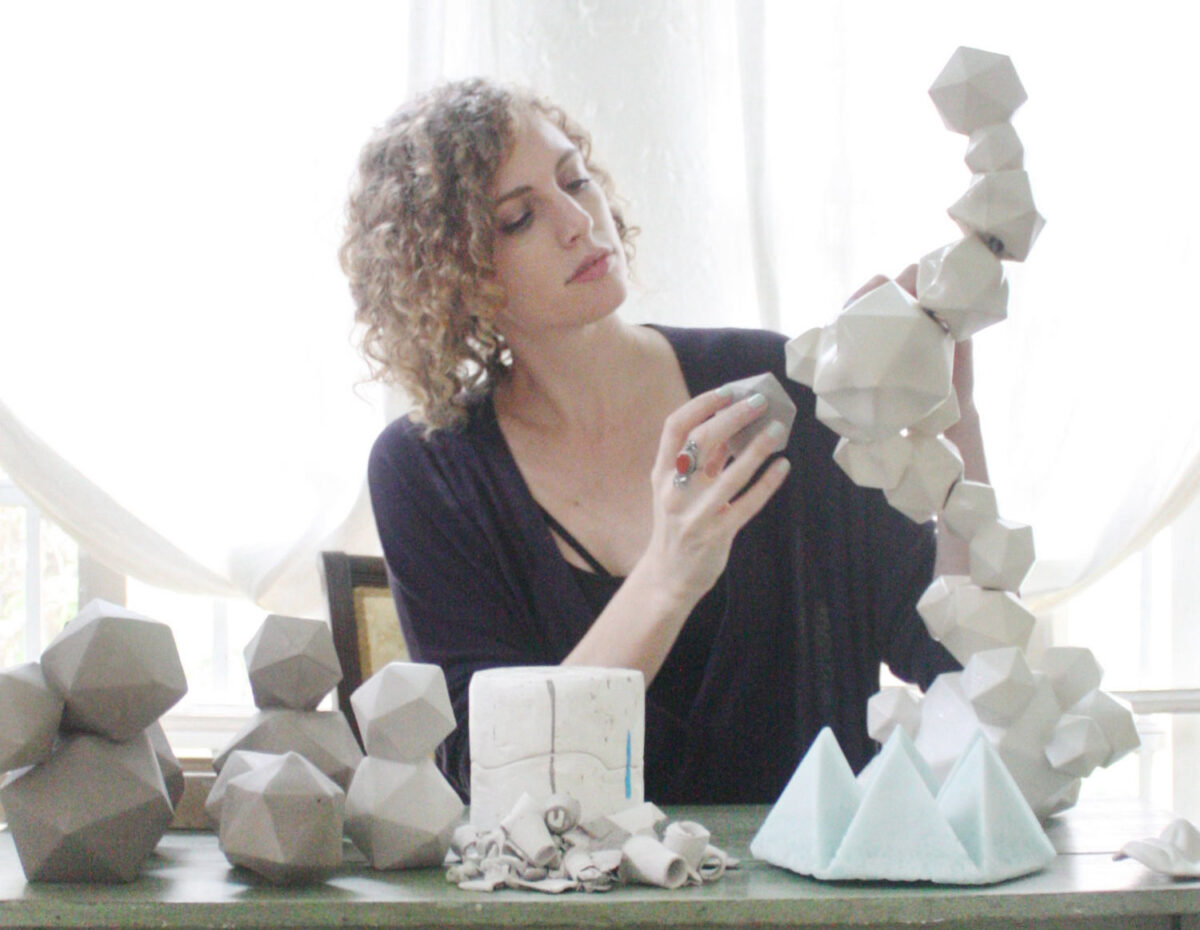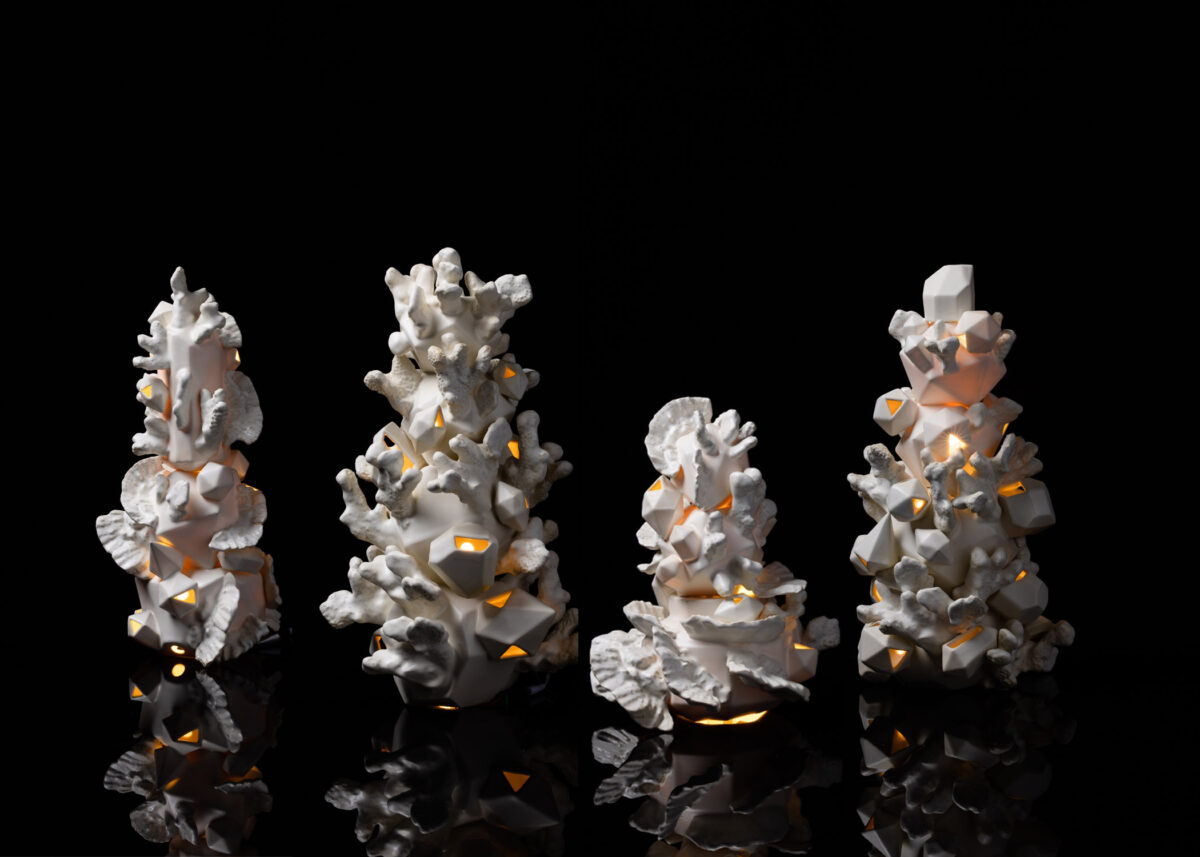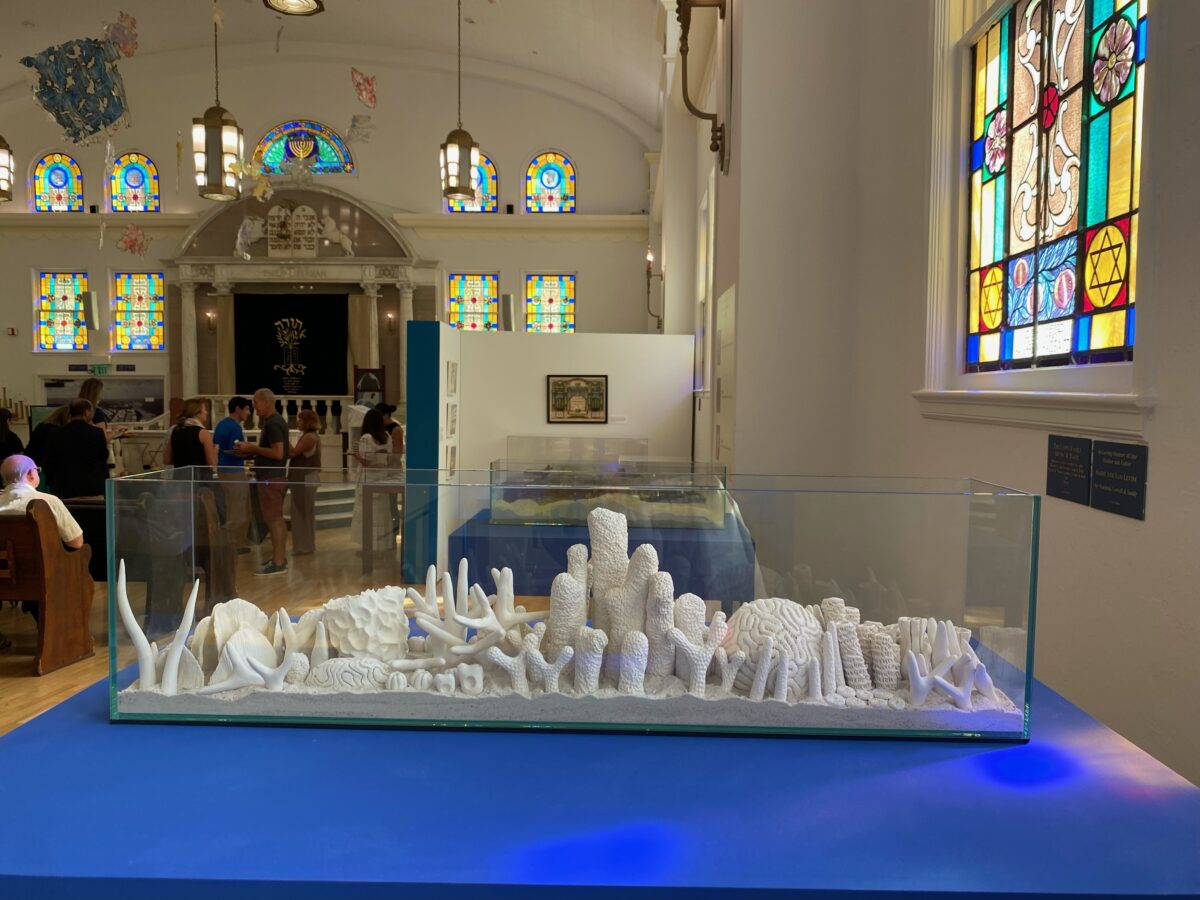
News Travels Fast
‘Fragile Beauty’ exhibition connects Jewish artists with the environment
The combination of eco-inspired works by Mira Lehr, Lauren Shapiro and Beatriz Chachamovits is running through spring at the Jewish Museum of Florida
Miami, known for its vibrant nightlife, bustling art scene and beautiful beaches, is also ground zero for sea level rise. With the same vigor, city officials are scrambling to find ways to elevate homes, build earthen berms and erect tall sea walls, while simultaneously organizing a weeklong showcase of artistic excellence — making it the perfect spot for an exhibition of three artists whose work calls attention to the problems facing the environment.
Mira Lehr, Lauren Shapiro and Beatriz Chachamovits are no strangers to the dichotomy. Separately, the three Florida-based artists create pieces that merge the beauty of nature with its harsh realities, but have come together to paint an even more powerful picture with their newest joint exhibition, “Fragile Beauty.”
Showing through April at the Jewish Museum of Florida in Miami Beach, “Fragile Beauty” combines the trio’s individual works into a larger message about the changes happening to the planet and its struggling ecosystems. The exhibition had its official opening on Dec. 4, the final day of Miami Beach’s annual Art Week.
The seven-day event, which this year culminated in the 20th anniversary of Art Basel Miami Beach earlier this month at the Miami Beach Convention Center, brings local and international artists together for a celebration of works along the city’s coastline.
Though their collaboration was put together by the museum, Lehr, Shapiro and Chachamovits are happy to be spreading their message together.
“Women have been thought of as nurturing, which fits in so well with the concept of protecting the planet. I am very pleased to be showing with two other female artists who are sensitive to the environment and who are helping focus attention on it and help protect it,” Lehr told Jewish Insider.
“As women, we have a more natural connection with the earth just because of how our body is, how we think, how our process is,” Chachamovits told JI. “We give birth, our body changes just like nature itself to create something new, and that relationship is really deep. So in a way, three female artists that are working in the same role, [coming] together to create an exhibition, I feel that it always makes the voice louder of the situation that needs to be dealt with or seen…that’s ultimately, I think, what we all want to see, the change that we’re asking for.”
*****
Lehr, who was featured in two other exhibitions during Art Week Miami Beach in addition to “Fragile Beauty” — a group show titled “The Miami Creative Movement” at the Center for Visual Communication in Wynwood and a solo show at Rosenbaum Contemporary Gallery in Boca Raton — has been a prominent figure in the art world for over five decades. At 87, her work has shown in over 300 solo and group exhibitions, and been featured in museums and galleries across the country, including the Metropolitan Museum of Art in New York City and the Smithsonian Museum of American Art in D.C. She’s been profiled by the Miami Herald, New York Times and is the subject of a career-spanning monograph Mira Lehr: Arc of Nature.
Lehr’s career, however, has not been without its challenges. Born in Brooklyn but raised in Miami, Lehr remembers the antisemitism she faced after moving from central to northern Miami Beach, which was predominantly Christian.

“I was asked the first day of school what my religion was and when I replied ‘Jewish,’ a bunch of kids said, ‘Oh my God, another one!’ When walking home from school, a kid shot a bobby pin into my ear and said, ‘Let’s get rid of the Jews,’” she recalled.
While experiences like those made Lehr “frightened and very conscious of being a minority,” she added that they also made her more empathetic, empowering her to fight for social causes like climate change and fair publicity for women in the arts.
In 1960, Lehr co-founded Continuum in Miami Beach, a co-op gallery aimed toward highlighting female artists — Lehr told Hamptons Art Hub that in the Southeast at the time, women in art were all but ignored.
“We all hated being here,” she told Hamptons Art Hub in 2015. “This was the boonies, nobody paid attention. Being a woman artist at that time was difficult. I thought, ‘I’m just doing this because I love when I’m learning. Whatever happens, happens.’”
Out Front Magazine described Continuum to be a “space for women to learn and expand their work on the realms of creation.” The gallery closed in the early ‘90s after operating for 30 years.
A self-described eco-feminist, Lehr’s first forray into using art for environmental awareness was in 1969, when she was chosen, along with one other artist, to aid in Buckminster Fuller’s “World Game” planet sustainability project.
“Fuller’s ‘Spaceship Earth’ vision was about the earth having a finite amount of resources, which cannot be resupplied,” Lehr said. “This was a year before the very first Earth Day was celebrated in 1970, and it was the year we sent a mission to the moon. I learned about linked and interconnected systems, which underscored the need to protect the planet, the necessity of guarding the planet’s resources, and of putting our energies towards doing more with less.”
“As I have made my way in this world, being Jewish has made me more sensitive to working on subject matter that promotes the message of wholeness, justice and peace. I have found, and continue to explore my voice, and speak up for doing what is right. Cherishing and protecting the environment is something that is ‘right,’” Lehr said.
Lehr has three pieces currently on display as part of “Fragile Beauty”: “Sacred Dreams,” which was donated to the museum as a permanent installation, “Mangrove Sculptures” and “Below the Surface.”

“The suspended resins of the large-scale aerial installation ‘Sacred Dreams’ are lit by the lovely stained glass windows all around and bathed in the natural sunlight that streams in, creating an ethereal experience. The strength and interconnected roots of the ‘Mangrove Sculptures’ installation, along with the luminous, swirling energy of ‘Below the Surface,’ combine to evoke an appreciation of the connection among air, earth and water,” Lehr said.
“These works hopefully cause viewers to not only reflect on the structure and integrity of the pieces, but to expand their thinking about structure, integrity, and cohesion of the planet,” she added.
*****
Shapiro, an artist-in-residence at the Bakehouse Art Complex in Miami, began working with sculpture over 15 years ago while getting her Bachelor of Fine Arts degree from Florida Atlantic University. The 38-year-old went on to get a master’s in ceramics from the University of Miami. Her work has been featured in a number of solo and group exhibitions, and has received several awards, including a grant from the Andy Warhol Foundation for the Visual Arts in 2019. She has appeared in publications such as the Miami Herald and Architectural Digest.
Combining art, science and technology, Shapiro creates her work alongside ecologists, learning from them and subsequently helping “communicate their research to the public” via her installations.

“If you look at my work, you’ll see a lot of geometry and patterns and repetition instances, and these are all largely inspired by the hidden geometries that you see in nature and the idea that everything is connected,” Shapiro told JI.
“My pieces for the show are a new series of objects that incorporate some of these 3D scans of corals that were loaned by scientists in the field…and they’re kind of hand-built with these geometries and these objects that when you turn on a light they illuminate, so they’re actually light sculptures,” she said.
For Shapiro, presenting her work at the Jewish Museum of Florida felt like a reconnecting of sorts to the community she grew up in as a child.
“I grew up with a more traditional family, I had a bat mitzvah, been to Israel, I was very much integrated with the Jewish community when I was younger,” she said. “Then as I’ve gotten older, I sort of haven’t been as involved in many, many years,so it’s nice to kind of be in touch with my roots, especially for art. This is the first time I’ve ever done anything like this for this community, so, it kind of makes me feel at home.”
While her exhibition sculptures, a series of “Crystal Coral Lamps,” make use of the techniques she has become known for, Shapiro’s interest in the environment began much earlier.
“I was born and raised in South Florida, and we spent a lot of time outdoors in nature, and nature has always been kind of a prevalent theme in my work as a professional artist,” Shapiro said.
Since then, she has traveled to places like Brazil and French Polynesia to learn about their ecosystems, but is currently focused on bringing attention to ecological changes happening closer to home.
“When I got out of grad school, I wanted to take that vocabulary that I developed and turn my lens on to the greater landscape of Miami, and to kind of thinking about the issues that we’re facing here,” Shapiro said. “We’re ground zero for sea level rise. Our city is built essentially on zero feet of sea level, so we’re gonna go under, or rather nature’s gonna start taking back the beach, essentially. I’m really interested in how people and nature can live more in tandem, more in harmony, because nobody wants to live in a barren wasteland. Everybody wants nature around us, so thinking about how we can critically solve problems and come together to sort of advocate for these types of issues.”

Shapiro clarified that her “Fragile Beauty” installation is not a call to action — as some of her others have been — but meant to inspire people “to make work, or to make art, or to be creative, or to use creativity.”
“I think people get very overwhelmed when they think about climate change. They feel like they’re helpless,” she said.
“Art has the power to inspire people and harness people’s emotions, because people don’t care about things that they don’t understand. Or rather, they don’t understand things they don’t care about, and vice versa. So when people see something that inspires them or makes them feel something, they’re more apt to care about it and want to protect it,” Shapiro added.
*****
Originally from São Paulo, Brazil, Chachamovits moved to Miami four years ago. Her work has appeared in numerous solo and group shows, including at the National Museum of Rio de Janeiro, and has been featured in Vogue and National Geographic’s education platform. She is the recipient of an artist grant from The Village of Pinecrest, and wrote and illustrated a handbook of marine life.
“Beatriz and I have known each other for many years and we’re good friends,” Shapiro said of sharing an exhibition with Chachamovits, a fellow resident at Bakehouse. “She’s assisted me in some of the installations that I’ve done when she first got to Miami a few years ago, and I’ve helped her with some of her stuff as well. We share a lot of commonalities, common friends and common themes in our work, so her and I are pretty close.”

“Working with Lauren is always awesome,” Chachamovits, 36, agreed. “This is not the first exhibition that we [have shown] together as well, and so having her and having this in our lives, I love it. I love [it] because we’re both ceramicists, we’re both environmentally oriented artists — she has her own way of doing things and I have my own way of doing things, but the way that that sum comes together, it’s really powerful. So, every time that we have a chance of working together or just exhibiting together I jump at it, because I think that in many ways our work complements each other and it creates an exponential understanding of the process and all the [problems] that [are] happening in the environment.”
Chachamovits’ art focuses on the decline of the earth’s coral reefs — with particular attention to what scientists say are their three main causes of deterioration: coral bleaching, ocean acidification and plastic pollution — a cause she literally swam upon.
While sketching seaweed around the island of Ilha de Boipeba during a trip through Bahia in Northern Brazil, a stranger came up to Chachamovits and asked if she had ever drawn the island’s corals, bringing out a pair of snorkels and offering to show them to her.
“He took me to this other beach, and we dove into the ocean and went to this part of the ocean that is filled with rocks, very close to the coast…he pushed me into the ocean and shoved me inside of this tiny little cave, and this cave was the most magical, most magnificent thing I’ve ever seen in my life,” Chachamovits recalled. “It had little openings on the roof so the light of the sun would shine through it, revealing and obscuring lights and shapes and forms. The cave was like 360-covered in corals and tiny fishes swimming from side to side. I could see a spotted ray just laying on the sand in the bottom and tiny critters moving around…that day changed me forever. I was so amazed by the beauty and the shapes and the textures and the form and the movement, and how harmonious everything was and connected to each other – that interconnectivity that happens inside of the blue ocean that is so visible. It really hit a nerve, and when I got out of it I was like, ‘Why isn’t anyone talking about this?’”
“We spent the whole day going in and out of that cave, and he took me to another spot to see bigger corals…and that changed me forever in such a deep way that I felt, because of this experience and because of this feeling that I had inside of me, I felt like that is my life’s purpose. If no one is talking about it, I’m going to talk about it,” she added.
Born to a Jewish family, Chachamovits mused that it makes sense she would be drawn to the ocean — and more specifically corals — having come from such an interconnected community.
“A coral in itself is a bunch of polyps joined together to form a being, and I feel like that represents very much what Jewish culture is,” she said. “We all come together to form a bigger body, a bigger understanding, a bigger community, and in that sense…I’m seeing really this connection between the ocean environment and the interdependence and the symbiosis that exists, that is so vivid and is so strong, inside of the ocean.”
“Maybe that is what brought me so close to it, because I felt that in my whole life. I felt that symbiosis, I felt that interdependence, I felt that collectivism and the communal part of it. And so, in that sense I would say that there’s a very clear bridge between what is a coral and what is a Jewish community,” Chachamovits added.
“Being Jewish is something that is beyond you. It’s your identity. When you are Jewish you will always be Jewish, there is nothing or no one or anything that can take that away from you,” Chachamovits said.
Her “Fragile Beauty” installation, “To Kill With Water,” is a performative piece made up of three aquariums in different stages of acidification. The first contains a collection of clay-based coral sculptures. The second contains the same sculptures, which Chachamovits will cover with water — the clay will dissolve slowly over time, mirroring the effect ocean acidification has on the world’s coral reefs. The third aquarium contains shapeless mounds of clay in murky water, acidification’s final stage.

“I feel like one of my biggest roles is to plant a seed of love for the ocean,” Chachamovits said. “I really want people to understand that the way that we walk around the planet and the way we walk about our lives, and the choices we make, all of them influence our environment.”
“I would love for people to understand, in the deepest way, that we’re all connected to the water and we all need the ocean to exist and to survive [on] this planet. There is no life without water, and corals are the most important and most fragile ecosystem that we have, because they hold 25% of all life in the ocean and they’re less than 1% of coverage in the whole ocean. So it’s an important thing for us to realize how beautiful, magical and important they are,” she added.


